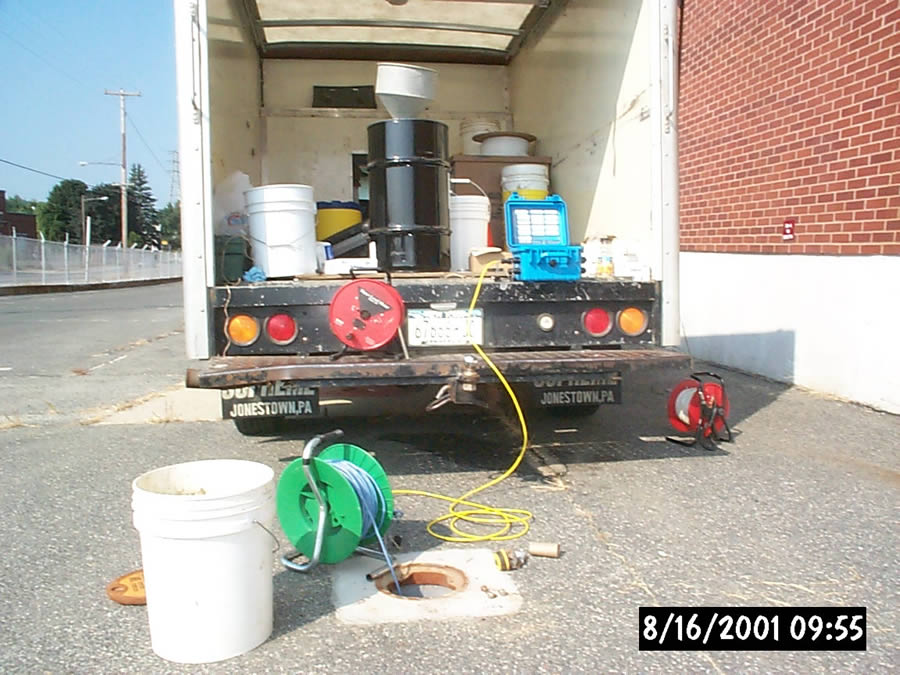Groundwater of the GE-Pittsfield/Housatonic River Site
Overview of Groundwater

Groundwater in Pittsfield area of Site generally flows toward, and discharges up into, the East Branch of the Housatonic River, Silver Lake or Unkamet Brook. Groundwater contamination and any associated light non-aqueous phase liquids (LNAPLs) on the surface of the groundwater would typically migrate towards and discharge into these water bodies in the absence of engineering systems designed to contain or remove the contaminated groundwater and LNAPL.
For administrative purposes, the groundwater at the Site has been segregated into five groundwater management areas (GMAs), as described below.
- GMA 1 - Plant Site 1 including the 20s Complex, 30s Complex, 40s Complex, East Street Area 2-South, East Street Area 2 - North, East Street Area 1 - North, East Street Area 1 - South, Lyman Street Area, Newell Street Area II, Newell Street Area I, and Silver Lake Area.
- GMA 2 - Former Oxbow Areas J and K.
- GMA 3 - Plant Site 2 including the portion of the Unkamet Brook Area east of Plastics Avenue.
- GMA 4 - Plant Site 3 including the Hill 78 Consolidation Area, the Building 71 Consolidation Area, the Hill 78 Area - Remainder, and the portion of the Unkamet Brook Area west of Plastics Avenue.
- GMA 5 - Former Oxbow Areas A and C.
Groundwater Monitoring Program
The overall objectives of the groundwater program at the Site are to ensure that contaminated groundwater and NAPL do not adversely impact surface waters, sediments, and biota, including those in the Housatonic River, Silver Lake, and Unkamet Brook, and also to ensure that contaminants in groundwater do not pose an unacceptable risk to human health via inhalation of vapors migrating from groundwater into occupied buildings. These two objectives are consistent with the classifications of the Site groundwater under the Massachusetts Contingency Plan (MCP) (310 CMR 40.0932).
The groundwater quality performance standards for the GMAs are based on the groundwater classification categories designated in the MCP. These categories are as follows:
- GW-2 (protection of indoor air) - Groundwater that is a potential source of hazardous vapors to indoor air. Groundwater shall be classified as GW-2 if it is located within 30 feet of an existing occupied building and the average annual depth to groundwater is 15 feet or less.
- GW-3 (protection of surface water)- All groundwater shall be classified as GW-3 because it is a potential source of discharge to surface water.
GE is required to meet the GW-2 and GW-3 groundwater standards for the compliance wells located in the GMAs, or take actions to ensure that groundwater constituents migrating into surface water do not pose an unacceptable risk to the environment or occupants of nearby buildings.
The GW-1 standard, protection of drinking water, is non applicable at the Site because this area of Pittsfield I served by a municipal water system, which has a water source well upgradient of the Site.
- Containment, defined as no discharge of NAPL to surface waters and/or sediments, which shall include no sheens on surface water and no bank seeps of NAPL.
- For areas near surface waters in which there is no physical containment barrier between the wells and the surface water, elimination of measurable NAPL (i.e., detectable with an oil/water interface probe) in wells near the surface water bank that could potentially discharge NAPL into the surface water, in order to prevent such discharge and assist in achieving groundwater quality Performance Standards.
- For areas adjacent to physical containment barriers, prevention of any measurable LNAPL migration around the ends of the physical containment barriers.
- For NAPL areas not located adjacent to surface waters, reduction in the amount of measurable NAPL to levels which eliminate the potential for NAPL migration toward surface water discharge areas or beyond GMA boundaries, and which assist in achieving groundwater quality Performance Standards.
- For NAPL located at depths of 15 feet or less from the ground surface and within a horizontal distance of 30 feet from an existing occupied building, a demonstration that constituents in the NAPL do not pose an unacceptable risk to occupants of such building via volatilization and transport to the indoor air of such building. Such demonstration may include assessment activities such as: NAPL sampling, soil gas sampling; desktop modeling of potential volatilization of chemicals from the NAPL (or associated groundwater) to the indoor air of the nearby occupied buildings; or sampling of the indoor air of such buildings.
Current Status
GE has implemented groundwater monitoring, assessment, and response programs at all of the GMAs. GE has completed baseline monitoring at all five of the GMAs. GMAs 1 and 3 are currently being monitored under long-term monitoring programs and both GMAs have plumes of non-aqueous phased liquids (NAPL) being actively collected. GE conducts NAPL removal at the East Street Area 1, Newell 2, East Street Area 2 – South, Lyman Street Areas, and Unkamet Brook Areas. GMA 4 is currently in the long-term monitoring phase. The long-term monitoring program has been terminated at GMAs 2 and 5. However, GE is required to maintain certain wells and to conduct additional monitoring at GMA 2 at five-year intervals.
Reports for Groundwater
The following list of reports and documents has been selected to provide an overview of the environmental investigations and remedial actions conducted for groundwater and NAPL (oil). Most of the available reports and documents were produced for General Electric by their environmental consultants.
- GMA 1 - GE Plant Site 1 (including Oxbows B and D through I and Silver Lake)
- GMA 2 - Former Oxbow Areas J and K
- GMA 3 - GE Plant Site 2 (including adjacent to Unkamet Brook)
- GMA 4 - Plant Site 3 (GE land between Plastics and New York Avenue)
- GMA 5 - Former Oxbow Areas A and C
- General documents that cover more than one GMA


